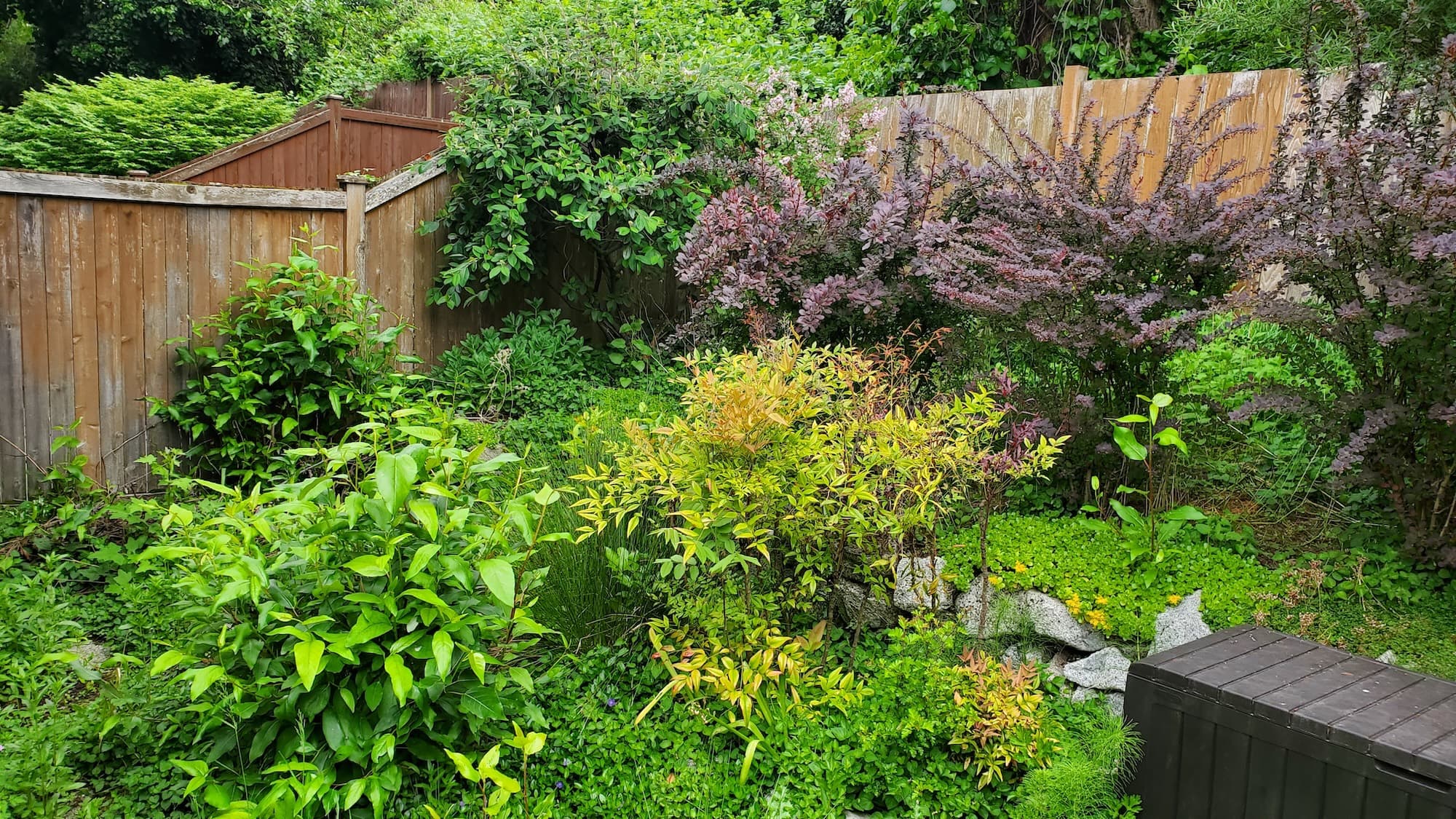West Seattle Pollinator Habitat Restoration
Homeowner’s Issue
West Seattle yards face a particular set of challenges when you want a real pollinator habitat. Soils are a mix of glacial till and compacted loam in upland pockets, with sandier, salt‑sprayed soils near Alki and Lincoln Park. We get around 35–40” of rain annually, heavy in winter and often compacting soils, while summer sun windows are short and critical for new plant establishment. Many lots have large maples or cedars, producing shade and moss, and slopes toward Admiral or Fauntleroy can drive water into low spots where plants drown or the ivy marches in.
Common pressures: Himalayan blackberry, English ivy, moss, and vigorous lawn grasses that outcompete seedlings. HOA curb‑appeal standards in some neighborhoods mean habitats must look tidy, not wild. That’s why local designs use layered native perennials and shrubs, placed for microclimates (south/ west‑facing beds get drought‑tolerant species; north shade belts get native shade lovers). We focus on improving soil structure, surface drainage on slopes, and timing planting for late spring or early fall so roots establish before dry late summer — all without chemical herbicides. The goal is a resilient patchwork of bloom across seasons that’s tidy, low‑water, and suited to West Seattle’s specific conditions.
Our Quality Service
We restore pollinator habitat using hands‑on ecological methods: site diagnosis, soil rebuilding, native plant selection, and targeted installation. We work with hand tools, electric pruners, small power tillers when needed, and sheet‑mulch techniques (cardboard + compost) to suppress weeds without chemicals. Typical timeline: a small bed (up to 200 sq ft) installs in 1 day; larger yards or slope stabilization take 2–4 days with follow‑ups.
Local insight: expect spring and fall planting windows to give best survival; protect new plantings from summer drought with mulched watering windows. On slopes we use contour planting and erosion‑control mulch to keep soil in place. We follow Seattle water restrictions and design to minimize summer irrigation after year two. Benefits include safer, pet/kid friendly spaces, improved curb appeal that satisfies HOAs, reduced maintenance, and stronger native plant communities that support bees, butterflies, and native flies.
What’s Included
- Site assessment and microclimate mapping (sun, shade, slope, drainage).
- Soil prep: aerobic decompaction, compost incorporation, and pH check as needed.
- Planting plan with native species selected for bloom sequence and site conditions.
- Plant installation: perennials, native grasses, and pollinator shrubs.
- Mulch application (shredded bark or compost) to retain moisture and suppress weeds.
- Initial two‑visit establishment care (watering checks, first weeding, staking as needed).
Options / Upgrades
- Wildflower seed mix or plug combos for meadow pockets.
- Sheet‑mulch (cardboard + compost) for long‑term weed suppression.
- Pollinator shelters (bee hotels) and twig piles for solitary bees.
- Organic, non‑chemical weed control packages: hand pull, smother, repeat gap planting.
- Haul‑away green waste vs. curb green‑bin disposal (client preference).
Before & After / Expectations
Expect some noise and a bit of a mess on install days: mulch deliveries, wheelbarrows, and green‑waste piles are normal. Access matters—gates, stairways, and street parking in Admiral and Delridge affect crew logistics; tell us about narrow alleys or steep steps ahead of time. Debris is sorted: invasive biomass hauled away or left for municipal green waste depending on client choice.
Timelines: small beds 1 day; medium yards 2–3 days; full restorations with erosion control up to a week plus follow‑up visits. Aftercare: water in the mornings for the first 6–12 weeks, wean irrigation by year two, and plan for repeat invasive control in the first two seasons (Himalayan blackberry and ivy often need follow‑ups). Moss responds best to light, drainage improvement, and raking — not herbicides.
FAQs
Q: Do you use herbicides?
A: No. We use physical removal, smothering, targeted replanting, and organic practices only.
Q: When is the best time to install?
A: Late April–June or September–October. Those windows let roots establish before the dry or the heavy rains.
Q: How long before I see pollinators?
A: Some bees and butterflies will visit within weeks; full seasonal diversity builds over 2–3 years as shrubs and perennials mature.
Q: What access do you need on narrow West Seattle lots?
A: We’ll need a clear path for wheelbarrows; if steps or alleys are tight, we plan for extra time and may use hand‑carry only.
Call to Action
If you live in West Seattle and want a tidy, dependable pollinator habitat that respects HOA lines and local microclimates, book a free estimate. We schedule quickly for Admiral, Alki, Fauntleroy, and surrounding neighborhoods and offer straightforward quotes after a photo review or short site visit. Local crews, practical installs, sustainable methods only.
Email: neatandtidyseattle@gmail.com
Phone: 206-538-9344
Ready to start? Send photos of the area and basic dimensions for a fast estimate.










